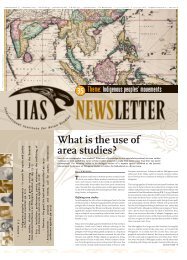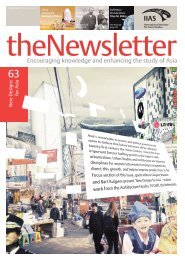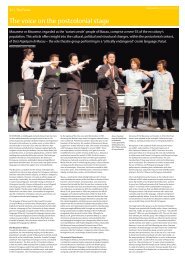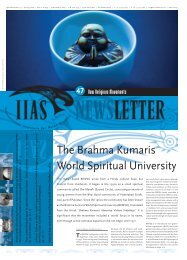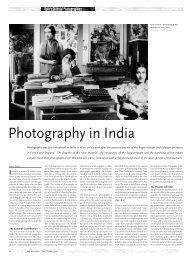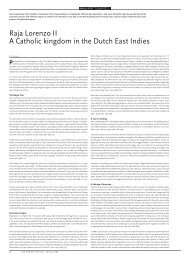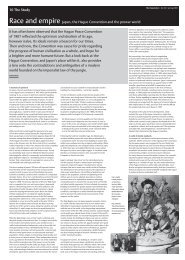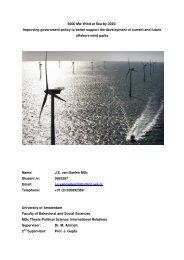Sex, love and revolution - IIAS
Sex, love and revolution - IIAS
Sex, love and revolution - IIAS
You also want an ePaper? Increase the reach of your titles
YUMPU automatically turns print PDFs into web optimized ePapers that Google loves.
R E S E A R C H<br />
Originality <strong>and</strong> plagiarism are the zenith <strong>and</strong> nadir of a wide range of authorial approaches found in writings. But how do such<br />
categories apply to past authors who shared sets of values quite different from the present ones? Aless<strong>and</strong>ro Graheli argues<br />
that careful adjustments are required for a sensible evaluation <strong>and</strong> interpretation of pre-modern works in the West <strong>and</strong>, even<br />
more, of most Sanskrit texts.<br />
In praise of<br />
repetition<br />
Aless<strong>and</strong>ro Graheli<br />
Academic acceptance <strong>and</strong> individual recognition are two primary<br />
needs of writers within the scientific community. The former prompts<br />
conformism to predecessors’ works while the latter stimulates creativity<br />
<strong>and</strong> invention.<br />
In average academic writing, the drive toward academic acceptance is<br />
manifestly expressed by the amount of bibliographic references or credits<br />
to other authors. Specifically, most authors belong to a school or tradition<br />
which inspires their method <strong>and</strong> ideas. More generally, every writer<br />
is consciously or unconsciously indebted to others due to the very nature<br />
of the linguistic phenomenon. Communication is a process that requires<br />
a platform of syntactical rules, lexical familiarity, conventional stylemes,<br />
<strong>and</strong> so forth, shared by the writer <strong>and</strong> his reader. It is a matter of common<br />
linguistic games or, in a diachronic perspective, of tradition in the sense<br />
of inherited linguistic habits.<br />
The second need – individual recognition – implies the idea of some<br />
subjective, creative role on the writer’s side. The yardstick of originality<br />
is often used to label authors on a scale of values ranging from the<br />
literary genius to the shameless plagiariser. One should keep in mind,<br />
however, that both tendencies – conformism to one’s tradition <strong>and</strong> individual<br />
originality – are culturally <strong>and</strong> historically specific. Particularly, the<br />
modern notion of intellectual property is laden with the post-cartesian<br />
transformations of the concepts of ‘subjectivity’ <strong>and</strong> ‘objectivity’, which<br />
have met with alternate fortunes in the last centuries. To mention just a<br />
few late developments, Western thought has experienced the existentialist’s<br />
primacy of the subject, the structuralist’s focus on the object, <strong>and</strong> the<br />
post-modernist’s destabilisation of both. Yet, despite the efforts of many<br />
philosophers who have to a great extent exposed the delusion of originality,<br />
it seems that we cannot do, in fact we never did, without the magic of<br />
spontaneity, creativity <strong>and</strong> novelty as marks of literary excellence, while the<br />
phantom of uncredited repetition lurks behind each of ours <strong>and</strong> others’<br />
words <strong>and</strong> sentences. In art, but also in academic <strong>and</strong> scientific papers,<br />
plagiarism is dreaded as a major violation, so much so that the craft of<br />
quotation <strong>and</strong> bibliographical information, <strong>and</strong> the length <strong>and</strong> quality of<br />
our bibliographies <strong>and</strong> databases, have long become m<strong>and</strong>atory assets.<br />
In this predicament one may notice a schizophrenic attitude, with interesting<br />
epistemological outcomes, involving the polar urges for compulsive<br />
repetition <strong>and</strong> for idealised novelty.<br />
The two extremes have their counterparts in two distinct logical domains,<br />
deduction <strong>and</strong> induction. In deductive inferences the piece of knowledge<br />
contained in the conclusion is comfortably narrower than that implied in<br />
the premises, resulting in certain but tautological knowledge: due to formal<br />
requirements, the conclusion cannot yield any new information (this<br />
is sometimes dubbed as ‘the paradox of deduction’). The inductive process,<br />
conversely, has a stronger heuristic potential but also the unavoidable<br />
uncertainty of the knowledge produced. In classical India inferential processes<br />
were eminently inductive, <strong>and</strong> most schools of thought included the<br />
appeal to authority among valid epistemic tools, exactly to counterbalance<br />
the weakness of sense perception <strong>and</strong> the uncertainty of induction.<br />
I will give here a sample of the stance of three important Sanskrit writers,<br />
who have set a l<strong>and</strong>mark in their respective disciplines <strong>and</strong> traditions, on<br />
the issue of repetition <strong>and</strong> invention. These three stalwarts were all prolific<br />
<strong>and</strong> eclectic authors who wrote in many capacities. Simplifying, however,<br />
Jayanta Bhassa (9 th –10 th c. CE) was eminently a logician, Abhinava Gupta<br />
(10 th –11 th c. CE) a literary theorist, <strong>and</strong> Jgva Gosvamin (16 th c. CE) a theologian,<br />
at least in the context of the works quoted here. Furthermore, in<br />
relation to creativity, I should add that they also wrote poetry, or at least<br />
displayed a poetical penchant in their writings.<br />
The apology of invention<br />
Jayanta’s NyAyamañjarG is an encyclopaedic work on logic <strong>and</strong> epistemology<br />
which presents with remarkable efficacy <strong>and</strong> honesty most rival theories<br />
in these fields. In the proemium, Jayanta describes his achievement<br />
<strong>and</strong> his deference to the tradition as follows:<br />
How could I ever be capable of inventing anything new? Here readers<br />
may rather judge the beautiful arrangement of statements. Garl<strong>and</strong>s<br />
manufactured in the past generate new curiosity if strung again with<br />
those very flowers on a br<strong>and</strong>-new thread (NyAyamañjarG 1.7–8).<br />
In his commentary to the NASyaPAstra, an ancient work on dramaturgy,<br />
Abhinava surveys <strong>and</strong> criticises previous aesthetic theories <strong>and</strong> justifies<br />
Tripasha layout, with root-text in the centre. Jgva Gosvamin, Durgamasakgamang ad Bhaktirasamotasindhu, f. 3 recto, copy dated 1711-1712 CE.<br />
Courtesy of Oriental Institute, Vadodara, India.<br />
their ruthless dissection with the following statements, which sound<br />
almost as an apology for his sharp analysis of his predecessors’ arguments:<br />
How can this be anything new, if it was established by tradition? It<br />
is just the apprehension of something already known, albeit within<br />
an exp<strong>and</strong>ed awareness. Isn’t because of such a conflict, between<br />
something readily available <strong>and</strong> something of great value, that people<br />
find faults? Climbing higher <strong>and</strong> higher, the restless intellect observes<br />
reality, which is the fruit of many theories conceived by former thinkers<br />
on the ladder of discrimination. Indeed, what I find strange is that<br />
the first approach in the ascertainment of the object of knowledge can<br />
be groundless, while to build bridges <strong>and</strong> cities – once the right path<br />
has been determined – is not a reason of surprise. Therefore, here the<br />
opinions of wise people have not been censured, but rather improved,<br />
because they pass down a fruit whose support is rooted in formerly supported<br />
theories (Abhinavabharatiad NASyaPAstra 6.33).<br />
In the beginning of his opus magnum on kOQLaite theology, the BhAgavatas<strong>and</strong>arbha,<br />
Jgva acknowledges a two-tiered debt to former authors:<br />
his task, he writes, was that of a mere reorganiser of material written by<br />
his predecessor Gopalabhassa, who was in turn indebted to prior theologians:<br />
This tiny soul [ Jgvahere refers to himself in the third person] writes after<br />
studying <strong>and</strong> rearranging the work of Gopalabhassa, which was somewhere<br />
structured, somewhere unstructured, <strong>and</strong> somewhere incomplete.<br />
This Gopalabhassa, who belongs to a lineage of Southern brahmalas,<br />
wrote after a thorough examination of senior masters’ writings.<br />
In his own elaboration on this very passage, he explicitly says that the<br />
purpose of this statement is to clear the ground from suspects of original,<br />
self-made ideas in his work. Such an uncompromised reliance on the principle<br />
of authority – <strong>and</strong> conversely the minimisation of the author’s subjective,<br />
creative role –are hardly surprising in the case of a theologian, as<br />
Jgva mainly is. Theological arguments, in fact, derive most strength from<br />
the appeal to authority. But one should keep in mind that behind such<br />
credits to tradition <strong>and</strong> disclaimers of novelty there is an epistemological<br />
stance which is shared by most Sanskrit authors: knowledge does not<br />
come only from perception <strong>and</strong> inferential processes. Verbal knowledge,<br />
or, better, knowledge which is linguistically-acquired from genuine or traditional<br />
sources, plays a major role in everyone’s life.<br />
The defence of the epistemological value of tradition is a leitmotif in the<br />
South Asian history of ideas. ‘Tradition’ has in this context at least three<br />
intersecting meanings, diversely relating or clashing with the concept<br />
of novelty. Firstly, mainstream schools of thought such as Nyaya <strong>and</strong><br />
Mgmaisa defended the validity of scriptures (the Veda) as autonomous<br />
sources of information about religious matters(tradition in the sense of<br />
holy text). Secondly, they did so in a social context which widely accepted<br />
the value of such scriptures (tradition in the sense of a shared set of values).<br />
Thirdly, their basic assumption was that linguistic transmission is<br />
the foundation of knowledge (tradition as verbal transmission).<br />
Authors <strong>and</strong> commentators<br />
A general feature of Sanskrit literature is that even in original works, where<br />
one expects an implication of novelty <strong>and</strong> creativity, writers more or less<br />
explicitly express a debt with tradition. But it is in commentaries, which<br />
more naturally tend to minimise originality, that we are more likely to find<br />
a thematisation of the novelty-vs-repetition issue, if not because of the<br />
very nature of the meta-linguistic analyses <strong>and</strong> the explicit role of commentators<br />
as interpreters of their authors of reference.<br />
Despite their different approaches, in the above passages Jayanta, Abhinava<br />
<strong>and</strong> Jgva share a common trait: they all claim a role of commentators<br />
or reorganisers of ancient root-works(the NyAyasTtra, the NASyaPTstra <strong>and</strong><br />
the BhAgavatapurALa, respectively) or of their predecessors’ commentaries<br />
upon such works; moreover, they all try to avoid the ‘stigma’ of creative<br />
writers <strong>and</strong> claim a role of editors, rather than authors.<br />
All three ultimately refer to ancient root-texts whose authors (Gautama,<br />
Bharata <strong>and</strong> Vyasa, respectively) did not leave any historical information<br />
about themselves. nor did Abhinava, Jayanta or Jgva have any, apparently.<br />
The individuals called Gautama, Bharata <strong>and</strong> Vyasa seem to be remembered<br />
only in a mythical time. This can be considered as another evidence<br />
of the predominance of a de-individualised tradition over the single personalities<br />
constituting it.gThere is another way these Sanskrit commentators<br />
relate to their predecessors. Most philosophical treatises are crafty<br />
fabrics of interwoven rival theories, presented in a dialogical form of objections<br />
<strong>and</strong> counter-objections. The complex architecture of such arguments<br />
<strong>and</strong> counter-arguments is generally sealed by a final verdict, representing<br />
the tradition of the writer. Opponent schools, in turn, structured their own<br />
theories in a specular fashion. Several such treatises are still extant in<br />
some form <strong>and</strong> are witnesses of a gradual <strong>and</strong> increasing refinement of<br />
ideas which took place over centuries of proposals <strong>and</strong> rebuttals. In retrospect,<br />
we can safely say that the incorporation of one’s opponent’s views<br />
was hardly a rare phenomenon, although generally not openly acknowledged,<br />
<strong>and</strong> that there is a mutual debt for intellectual growth among traditions<br />
such as Buddhism, Mgmaisa, Nyaya, Vedanta etc.<br />
Such treatises are in the overwhelming majority commentaries on previous<br />
works. As such, commentaries constitute in the literary l<strong>and</strong>scape<br />
of South Asia a genre with sub-genres, with a peculiar structure, style,<br />
lexicon <strong>and</strong> even manuscript layout. Root texts are generally composed<br />
in metrical verses or in aphorisms, while the commentaries are often in<br />
prose or verses <strong>and</strong> prose. When reproduced along with the commented<br />
works, some of these commentaries are laid out in a three-blocks (tripA-<br />
Sha) format, with the indented root-text in the middle of the page, often<br />
in larger characters, <strong>and</strong> the related portion of commentary framing the<br />
root-text above <strong>and</strong> below, thus giving a visual effect of hierarchy. As with<br />
the scholia of Greek <strong>and</strong> Latin classics, due to relevance <strong>and</strong> circulation<br />
reasons some of these commentaries acquired a status of independent<br />
treatises <strong>and</strong> begin to be transmitted independently, to be in turn commented<br />
upon later on.<br />
Innovation within the tradition<br />
In sum, the rough material used by Sanskrit writers can be largely traced<br />
back to former works. Theirs, however, is the framework <strong>and</strong> the organisation<br />
of the material. Theirs is also the assessment of the relative strength<br />
of the sources’ arguments <strong>and</strong> hence the critical evaluation. Most unoriginal<br />
writers can be thus said to have been critical compilers, rather than<br />
mere copyists or plagiarisers, who freely used their traditions’ works <strong>and</strong><br />
ideas.<br />
The great proliferation of commentarial works in South Asia is further<br />
evidence of a widespread inclination to depend on the authority-principle<br />
rather than one’s own creativity. Scholars who approach these classics<br />
are advised to keep this principle in mind, try to divest themselves of<br />
post-cartesian prejudices on the author’s subjectivity, <strong>and</strong> use with great<br />
care labels such as ‘creative author’, ‘shrewd plagiariser’, ‘brilliant reinterpreter’,<br />
or any other epithet which presupposes the notion of intellectual<br />
property. In Sanskrit literature, in fact, the property seems to relate to the<br />
tradition rather than the individual. The room left for the author’s own<br />
innovations is explicitly denied, implicitly allowed with specific limitations<br />
<strong>and</strong> regulated by epistemological <strong>and</strong> deontological assumptions which<br />
require a close examination.<br />
Aless<strong>and</strong>ro Graheli<br />
University of Turin, Italy<br />
a.graheli@gmail.com<br />
2 4 I I A S N E W S L E T T E R # 4 8 S u m m e r 2 0 0 8



